
You know what? Let's close the year out with a post about another roguelike - why not? I guess I'm a genre blogger now. That's fine.
So apparently Spike Chunsoft made a whole game about the DLC outfit in KATANA KAMI! Here I am facetiously referring to Mystery Dungeon: Shiren the Wanderer 5: The Tower of Fortune and the Dice of Fate, which has recently been re-released on Switch and PC. Typing that name out (or rather looking it up on Wikipedia to make sure I remembered which part was of fate and which one was of fortune) I realised that the re-release dropped the "Mystery Dungeon" part from the title, which to me is a shame, because I like that series and I feel like if you're going to have a subtitle that long you're past the point of saving for a more concise game name.
The other reason I think it's a shame is because Shiren the Wanderer does have an interesting position in the larger Mystery Dungeon canon by virtue of being the only series in it that isn't a spin-off. Every MD game pulls some mechanical inspiration from the franchise it's set in - the Pokemon ones usually feature some sort of collection mechanic, the Chocobo ones have a job system and I can only assume the Dragon Quest ones have soundtracks composed by an awful decrepit fascist1,2. It's interesting to see what kind of framework Chunsoft put together for a roguelike that doesn't have an existing setting (with existing monsters and things like elemental magic/skill affinities) to base the entire game on.
1: For the sake of notekeeping I will say Koichi Sugiyama also worked on Shiren the Wanderer 1 and 2, though the soundtracks for the later games in the series are credited to Hayato Matsuo.
2: The first Mystery Dungeon game actually was a DQ spinoff, and Shiren 1 was the sequel, so, aside from the "merchant collecting wares from a dungeon" angle the DQ ones are largely kind of spin-less compared to the other tie-in ones.
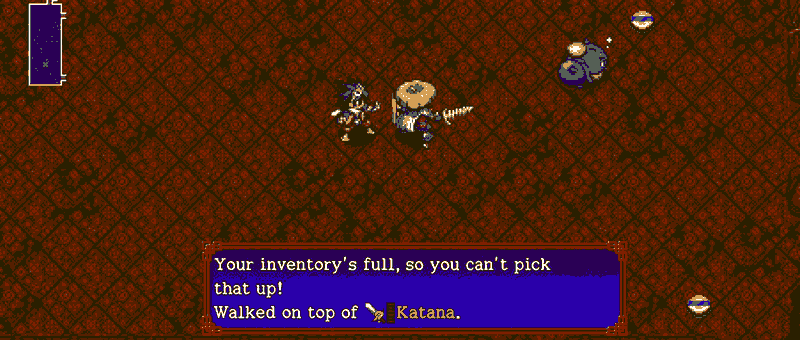
The framework, as it turns out, is pretty complex - more than I was expecting based off of my time with Chocobo MD, at least. There's around 55 in-game tutorials to teach you everything from basic roguelike concepts to large-scale mechanics like the day/night cycle, which forces you into a kind of spellcasting playstyle for a while (night monsters are nearly immune to physical attacks), to niche scenarios like throwing a pot with an item-stealing monster inside it across a moat so it can pick items up off the ground for you. Certainly the tie-in Mystery Dungeons have their own areas of complexity (like the job system in Chocobo, even just unlocking some of the later ones), but it's generally an outside-of-dungeon complexity. Shiren 5 (also Shiren ToFDoF), by contrast, has a surprising amount of complexity on the board. Hidden traps do anything you'd expect them to from making you blind or hungry to warping you across the floor, usually into an incredibly bad situation. There's very few variations of enemies that just directly attack you with nothing else going on - I've run into guys that use consumables off the ground against you (or for you, too - they're not very smart and don't differentiate between positive and negative effect), guys that lay traps, guys that steal your wands and digest the charges out of them, and probably a dozen more guys with unique special abilities, and my in-game bestiary informs me I've only seen 24% of the monsters in the game.
The in-game bestiary both lists every enemy's special ability and also presents you with some flavour text in that specific japanese localization tone that always cracks me up (and also reminds me of the flavour text in KATANA KAMI, which would make sense).
"The heavens, earth, and citizens of the world are calling to me. They tell me to defeat the wanderers. That's what I am summoned for." You know, wanderers aren't the villains in this game...
"It blows whistles and chases after wanderers, and is said to be popular online. Time to beat the crap outta them."
All of this environmental complexity, coupled with the lovely sprite work3, makes for a pretty unique experience - a traditional roguelike where I'm constantly saving video clips. For a completely turn-based game, Shiren 5 has really good comedic timing. I have a clip I've rewatched maybe 20 times of me carefully navigating a night-time room, worried about running into monsters, only to step on a launcher trap that throws me across the floor in front of an enemy with a strength buff that kills me in one hit. The pacing of all of these steps is incredible, topped off with a great animation of my character falling to the floor with a loud "thump". I have another one of me trying to exit a dungeon floor, stepping on a confusion trap, and then triggering it maybe 3-4 more times before I manage to stumble into the exit.
A lot of these funny moments stem from the large amount of movement-based effects in the game - there's items that function like grappling hooks, lots of ways for you or your enemies to get knocked back into a wall (or off a cliff, whereupon you fall to a random spot on the current floor), enemies that can warp you as a special ability and so on. If you're really unlucky, one bad step in the Tower of Fortune can feel like you've briefly been transported into a Mystery Dungeon pinball spin-off.
<

3: A little ex-course about the graphics, since I couldn't find a way to fit it in naturally. Shiren 5's got a really interesting mix of genuinely very good, well-animated sprite art with some of the most garish UI work I've seen in a while. Almost every element is a primary colour - a shop, for example, shows you item prices listed in a fully bright black-on-green, in a window that is bright blue surrounded with a bright red frame (you can customise the windows, but the I've found the default combination to be the best one). Your UI is a green, cyan and yellow bar alongside some nondescript fullwidth sans-serif font. Despite all of this, I think I like how it looks. Roguelikes have to me always been a genre that tends more towards readability than pleasant aesthetics, so I don't mind some primary colours here and there.
This sort of contrast - nice environment/character art coupled with primary colour UI - got me to think of and compare Shiren 5 with some classic ASCII interface roguelikes. Games like NetHack and Dungeon Crawl Stone Soup do tend to have graphical tile options, but I almost never play with them on. The main reason is usually a lack of clarity - at this point it's easier for me to read what a group of red and purple os is rather than try and parse another artist's attempt at a low-resolution depiction of orcs and orc wizards. Shiren 5's monster sprites feel functionally closer to the symbolic ASCII than to artistic attempts to turn a terminal roguelike into an immersive experience, since all enemies are distinctly colour coded, and their appearance is easy to associate with their primary function (like the various guys with big swords that do 40 damage per attack, or Yanpii the funny delinquent bird with a battering ram pompadour that knocks you off the map with its charging attack).
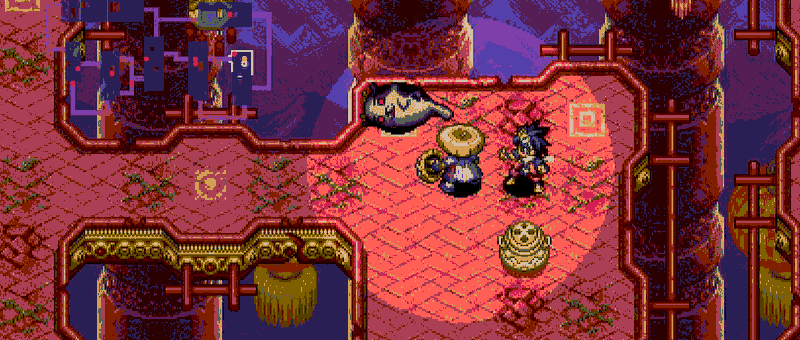
A couple hours into the game, once I've gotten comfortable with the hack-and-slash kind of dungeoneering of the early floors, I reach a checkpoint - a village roughly one third of the way up the main story dungeon - and after it, a new mechanic that has come to define all of my quickest and/or stupidest deaths yet - the day/night cycle. Aside from the obvious (you can't read most scrolls or see nearly as far without a torch - and this is true for monsters as well), the main twist of night-time is that monsters take very little damage from physical attacks. Instead of trying to hack away at them, you're intended to use magic. You get a little amulet with 8 slots in it, each of them occupied with a spell of your choosing. At first you just get two different damage spells, but as you encounter trainer NPCs throughout runs, you end up getting a pretty big variety of abilities that all serve different purposes. Each slot can (usually) be used only once per floor, so trying to put together a spellbook kind of feels like putting together a deck of cards, where you want enough workhorse spells to get you through basic situations while also having some kind of keystone. My current standby is Crawling Confusion and Electrocute, a two spell combo that pulls every monster on the floor to my current location, confuses them, and then kills them all with chain lightning. I felt like a real genius of spellcasting when I first came up with the combo, which is why I'm writing about it here in such detail.
The other main twist of night-time is that monsters will blindly walk around the dungeon, frequently bumping into one another, thus hitting and killing each other. Normally this would be a good thing, but in this game monsters also gain EXP and level up, so between that and my frequent attempts at running around without a torch means my last half-dozen deaths have been to a little kappa or tiger demon walking into me in a corridor and dealing 300% of my total health as damage in one hit. It sometimes feels weird that a shield I've upgraded to +15, a number that feels obscene to me in the context of a roguelike can be rendered useless in these situations, but I assume that's the game just telling me "you really shouldn't be doing it like this", and me just not listening.
Speaking of that +15 - upgrading your weapon and shield over time has been a central progression mechanic over the few Mystery Dungeons I played, and it's here too, in a slightly more complicated form - part of your upgrades come from blacksmiths or magic scrolls incrementing the number on your equipment by one at a time, the other part comes from actually using your equipment to level it up through stages. The Beast Sword I attached myself to early in my game is now something like "Great Beast King Sword". Each form change slightly increases how big the number can go on it. The third, and as far as I can tell final, part of upgrading is using synthesis to apply one piece's traits onto another - using a gold sword to make a better attacking item rustproof, for example, which to me feels like a mandatory trait if you want to make actual progress. The main story dungeon is definitely designed with gradual progress and milestone pushing in mind, just judging from the kind of stat growth the later floors expect from you compared to what you can get in a single run. I'd be slightly bummed about this, but apparently in the post-game there are several dungeons where you are forced to start empty-handed, so it's fine.
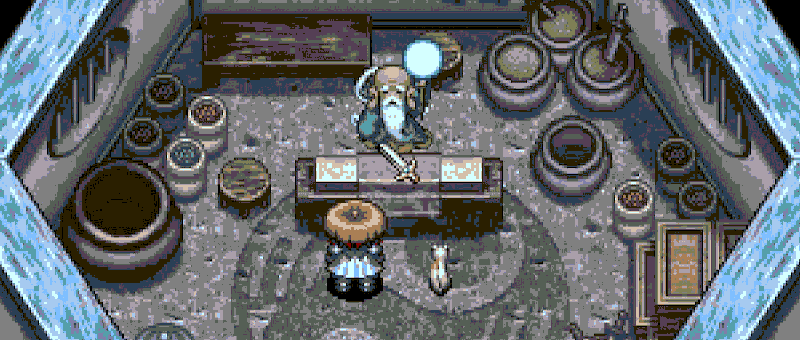
I was initially kind of worried about how necessary the equipment strengthening mechanic was - I fell off of Chocobo MD because I decided to play on Hard difficulty and ended up losing gear I'd built up over the first 5 or so dungeons, and I simply did not feel like repeating all of that work a second time. Fortunately Shiren 5 doesn't have this kind of over-confident gamer pitfall, and there's several ways to not lose your spoils. You can spend a (slightly sizeable but totally worth it) amount of money to tag your sword and shield, which means they will appear at the lost-and-found around 1/4 of the way into the dungeon. There's also various consumables that let you revive and/or zip out of the dungeon immediately, which feels kind of cheap until the 5th time you get ganked by one of those nocturnal tiger demons. All of these safeguards cost one or other kind of resource, so you do have to take some amount of care to make sure you come out on top in that regard.
Speaking from my maybe limited experience, having a slightly easier main story dungeon and increasingly difficult challenge dungeons is the way Mystery Dungeon games operate. I'm just glad the main story in Shiren 5 offers a higher and more dynamic challenge right off the bat.
There is also another, much more exciting safety mechanic in the game. In the main story dungeon (and some of the post-game ones too), if you die without any revival items on you, you get the choice to send out a rescue request - up to 3 times per dungeon run. This sends your current position out into the internet, where someone can pick it up, run the dungeon up to where you died, and come raise you from the dead. I think you can also just generate a password that someone else can type in, if you want a more directed choice of rescuer. When you send a request, you get to compose a little message out of a preset vocabulary. Your rescuer can also respond with a message of their own, and then you get to send them a thank-you note and attach an item if you're feeling thankful and generous. I am completely in love with this feature. I want to get through my story run as soon as I can so I can feel more confident in rescuing people myself, because I'd love to participate in it as much as I can before the playerbase for this niche console roguelike completely dries up.
I think a big part of why I'm so endeared by this feature, aside from generally being a fan of asynchronous co-op mechanics, is the fact that it kind of evokes NetHack's mail daemons, a feature that completely blew my mind when I first played the game in ~2005, a good several decades after the standardisation of TCP/IP for network communication. I had a cellphone by then. I'm not sure why the ability to spectate a telnet window and send messages to it was as fascinating as it was, but so it goes.
Shoutouts to Snake, top 6th rescuer on the English leaderboards at the time of writing, for being the first guy to save me from death. The wisdom he imparted to me: "You got saved. Learn from pain." So cool...
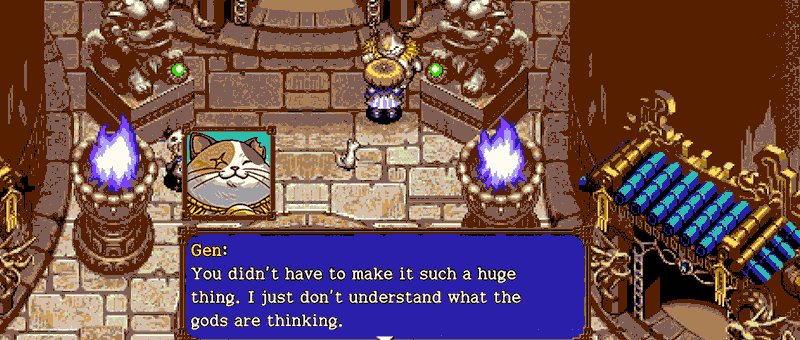
Writing about this game has helped me figure out another (in my opinion) important feature of roguelikes that frequently gets overlooked in attempts to define the genre. Most of the best executions of this kind of game tend to be really funny, if you've got the right mindset for it. This kind of extends as a side-effect of the mechanical complexity thing I've talked about here and there. It's less about how many moving parts there are, and more about how well they interact with one another. Spelunky 2, a game I have been completely unable to get good at (I'm not a platformer guy), is outstanding at this. Even though it's obviously a slightly different set of qualities that leads to comedy in a real-time game (Spelunky manages to squeeze a lot of humour out of the simple phenomenon out of ricocheting by virtue of having over a decade to tune the particulars of the engine), it's definitely there in the classics too. The only difference is seeing nonsense unfolding in real-time versus having to read a post-mortem text log to figure out why you went from 70 hitpoints to -21 in one turn.
As I mentioned before, Shiren 5 strikes a nice balance by being a fully turn-based game with excellent timing. Every action in the game has a nice little animation associated with it, and the game makes sure to give each line in the action log a moment to show up on screen before moving on. While the mini-pauses are mostly there to ensure you have had the opportunity to at least skim through all the information the game is giving you (and you can set options to make this faster, if you'd like), it ends up having a secondary function of setting a kind of meter for the things happening on-screen. I didn't spend too much time with Crypt of the NecroDancer, but I feel like I could see some kind of throughline between this and that game's basic premise.
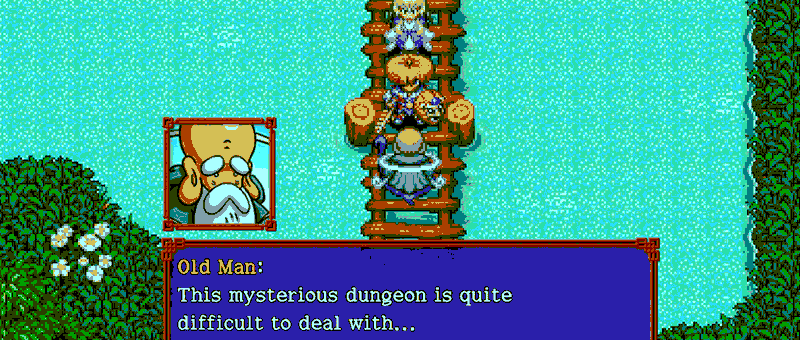
A wandering calligrapher NPC keeps giving me scrolls that I've never seen elsewhere in the game, ones with weird effects to boot (for example the Pot Dog Scroll, which summons a bunch of elephant enemies around you, and is intended to be confused with the very useful Pot God Scroll.) There's an entire tutorial about these 'lookalike' items, an idea that I imagine is much more effective in japanese, and weirdly a mechanic that I haven't run into in the course of the main story aside from this one instance. The only naturally unidentified items in the game are bracelets - if it isn't one you already have in your inventory, it'll just be called something like "Tourmaline Bracelet" instead of "Monster Detector". Thankfully, you can still identify these by equipping them and trying to figure out what effect they have. The first time I did this I thought "damn, now if only there was a way to name this item myself", only to figure out immediately that the game does have this function, and the menu for it includes pretty much every single item in the game, even ones that come pre-identified.
These hints towards even more mechanics at the edges of what I've been experiencing in the main story have been making me really curious. As I'm nearing what I assume is the end of it, I decide to spoil myself on some of the post-game dungeons. Among the list, one is described as "an even more mysterious dungeon". Reading through its modifiers, I'm now doubly excited to beat the story and get to these dungeons. Aside from making you start empty-handed, this one has every item start out unidentified, and the loot pool apparently includes every item in the game. While other post-game dungeons seem to be themed challenges (like one that is permanently night-time, or another one where you have to defeat enemies using traps), but this one sounds like it's just a straight-faced classic roguelike, engaging all the knowledge you've gained through your time with the game.
On my last run I managed to get to the final boss fight of the Tower of Fortune, which I had to warp out of because I didn't have the items I needed to counter specific fight mechanics. I suppose this isn't actually too far away from getting ganked by late-game enemies the first time you encounter them in NetHack, and the rest of this main dungeon has been about that "reach a plateau and come back better-equipped" kind of pace. Still, as my sword and shield get better and better (between the start of writing and now, I've leveled my Beast Sword to the point where its rank is a star instead of a number, so you know it's really good), and as resource demands leave me with less and less money to spend on loss prevention, I'm starting to look forward to those empty-handed challenge dungeons. As a veteran amateur of the genre, I know well enough to recognise when the lines "really good equipment", "time spent on a run" and "average challenge of the current floor" collide. This collision has historically always resulted in me looking at a high score list and thinking "well, I got more points on this run at least :)...". As the winter days grow colder, the idea of a full-on roguelike that I can play lying in bed sounds more and more appealing, so I'm really hoping to not drop the ball right before I get there.
~titas
yes i know nethack has a mobile client but i'm not about to play a game like that without a keyboard. it simply feels wrong






